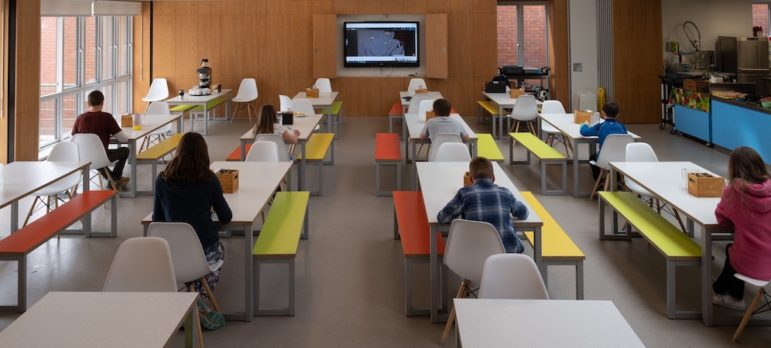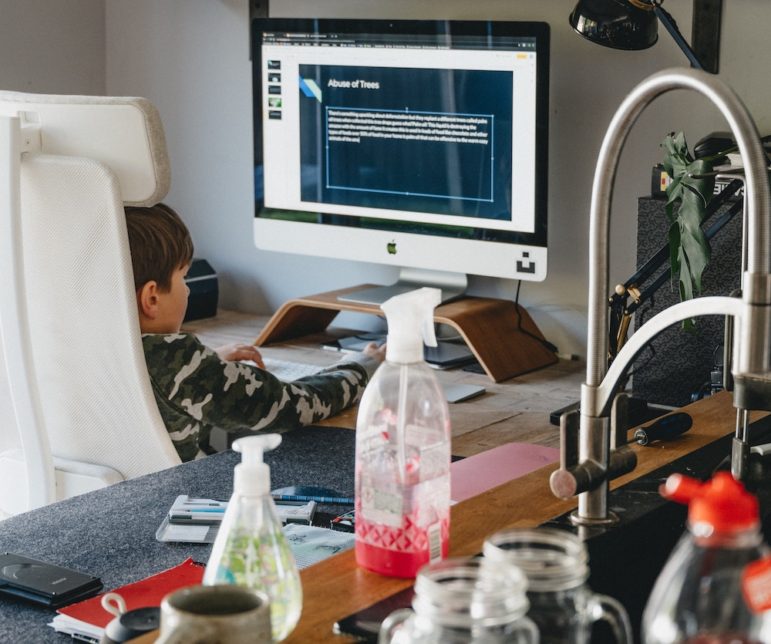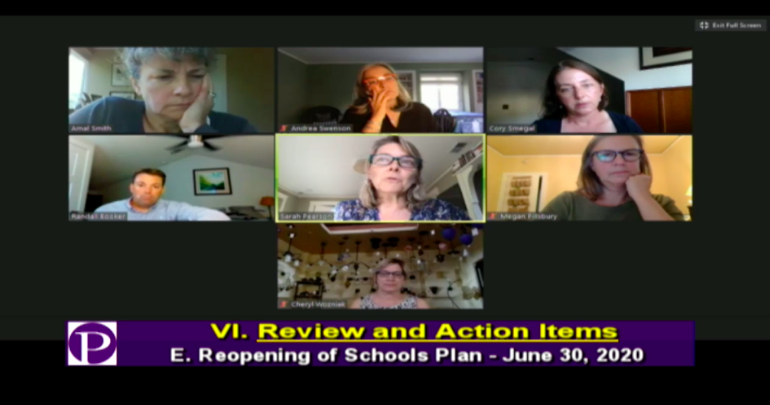At the June 30 Board of Education meeting, after eight hours of deliberation and lengthy public comment, the Board voted in favor of following a blended learning model with an emphasis on in-person learning across all levels of education for the 2020-21 school year.
The parameters set by the Board include: holding in-person classes four to five days a week, maintaining six ft. physical distancing, and cohorting students to the largest extent possible. (Cohorting is where students stay in the same small group throughout all of their classes in order to reduce exposure within the overall population.) Face coverings will be required for all grade levels and grades will return. The Board will re-assess any operational plan in September to see, among other things, if it would be possible to bring elementary students back full-time.
The Board also approved the new distance learning parameters as stated in the Board background and acted to allow those students that receive services under Special Education, IEP, or 504 plans to receive additional in-person instruction.
The parameters set by the Board and public health guidelines will guide the Bell Schedule Committee as they work to create detailed plans for each school site. The committee will meet from July 6 to July 8 and form a recommendation for the bell schedules which they will present at a July 10 special school board meeting. At the meeting, the Board can either approve or require an amendment of the recommendation.
Although the parameters are the same for all levels of district education, the Board has allowed the committee flexibility in creating different bell schedules for primary and secondary schools as needed.

Developments since the first reading of the reopening school’s plan
The decision follows several significant developments since the first reading of Booker’s reopening schools plan at the June 24 meeting.
- New social distancing guidelines have come out from both the Alameda County Public Health Department (ACPHD) and the American Academy of Pediatrics (AAP) that allow for less than 6 ft physically distancing in classrooms. This change increases the possibility of cohorting and gives schools more leeway to consider in-person learning, especially at the elementary level.
- Booker has removed the requirement of quarantining for 14 days after travel due to community feedback, the lack of recommendation by health centers, the logistical challenges it would pose for some families, and because California itself is a hot spot for cases.
“Right now New York is saying that if you come in from California you are going to have to quarantine for 14 days,” Trustee Andrea Swenson said. “[California is] the area that is considered dangerous.”
- The Board has learned that under Assembly Bill 77, any parent can request that their child receive full distance learning without a doctor’s note or proof of the student being medically fragile.
- The state is requiring distance learning in a much more structured way than the spring of 2020. Booker made the following adjustments to his recommendation which the Board approved.
- The recording of daily attendance
- Return to letter grades with assignments
- Students must attend distance learning sessions four to five days per week which includes both daily synchronous and asynchronous learning opportunities
- Special education and any other required service for a student’s individualized education program must be provided through a distance learning model
- Although teachers will be encouraged to use outdoor space where they can, Booker said that regulations including the education code often prevent school districts from utilizing certain outdoor spaces or buildings that would otherwise seem extremely plausible as a way to spread students out among the city’s various facilities. Booker said he expects to have even more limited facility space due to the expansion of schoolmates to provide childcare during the blended learning model.
Board and PUSD continue to hear from families
Booker said that he and the Board appreciated the parents, staff, students, and community members for their continued support and investment in the schools. They have received petitions and a significant number of emails.
“A tremendous thank you to all of our teachers and staff and all of our parents and community members as well for their commitment to our school and active, respectful, and inclusive civic engagement,” Booker said.
Some parents advocate for five-days-per-week plan
The Piedmont Partners for PUSD Reopening Petition is currently circulating around Piedmont. The petition calls for a five-days-per-week plan for the 2020-21 school year that maximizes in-person instruction. The petition also acknowledged the need to follow recommendations put in place by the CDC and CA DOE and the possibility of the need to pivot in response to future public health events for the safety of both students and teachers, according to their website. As of noon on July 2 , 766 Piedmont students, parents, and community members have signed the petition.
“A five-days-per-week in-person model will provide students with a consistent, in-person instructional time that is necessary to ensure their social, emotional well-being and academic growth,” according to the website.
Board Correspondent Cory Smegal said that the petition mirrored much of what had already been said at the June 24 meeting. However, the petition does not represent all of the perspectives of the Piedmont community, she said.
“We’ve probably had several dozen emails [since June 24] and they have been from a wide range of constituents,” she said. “The challenge is [that people have] different thoughts on what will be safe.”
Opportunities for community members to help
Booker said that there are four specific areas where community members can help the schools: following “bubble grouping” (limiting exposures by socializing in small groups), wearing masks, continuing to fundraise, and becoming substitute teachers.
“We ask the community to really pay attention to social distancing regulations from public health officials and to take that very seriously,” he said.
A social contract is an unstated agreement among the members of a society to cooperate for social benefits. Booker said that if students are going to come to school the entire community has to act in a manner that promotes safety.
“We want everyone to realize, and I think that with these numbers most people do, that this is a high exposure time and we all have to be careful and vigilant,” Board Member Dr. Sarah Pearson said. “We really don’t want people having a lot of social contacts prior to starting school. We want everyone coming in healthy.”
A similar principle applies to wearing masks.

“I ask that parents start helping their children practice wearing masks because masks will be required throughout the school day,” Booker said.
In terms of fundraising, about 30 percent of the school budget is derived from family contributions. Now, more than ever, it is important that these donations continue, Booker said.
“We do have serious concerns with how the school will handle its budget during the next fiscal year,” he said.
Finally, Booker said that he will be sending out information to the parents about how they can become substitute teachers. The district expects substitute teachers to be in extremely short supply because of the high possibility of teachers having to self-quarantine throughout the year, the lack of flexibility of teachers being able to cover for each other, and the shortage of substitute teachers in general.
Potential plan details
Although the Bell Schedule Committee will ultimately decide what a school week will look like in the fall, Board members had a lengthy and winding debate over the trade-offs of different learning approaches before settling on the high-level parameters noted above.
Some of the topics they discussed:
- Supporting stable cohorts as much as possible in order to reduce exposure to the larger population. Booker said that the goal is to reduce student and student-teacher contacts as much as possible.
- Requiring an off-campus lunch to ensure that all lunches are off campus so students do not remove their masks while eating. An am/pm model where the day is divided into two periods of time would most likely accompany this decision, allowing for a lunch break in between the two groups, Pearson said.
- Limiting secondary schedules to six periods to increase the possibility of social cohorting. This could take place of freshman P.E or a senior free period. However, most sophomores and juniors would have to give up an elective, Booker said.
Additionally, Board President Amal Smith said that if students were to come back to a full learning plan in the middle of the year, they would still have one less period.
- Having three semester-long period cohorts per semester at the secondary level. This would require the amount of periods to be reduced to six per year. This is based off of the model recently adopted by Alameda Unified. The Board would strongly consider providing AP boot camps near the end of the year for those who took the class in the first semester, Booker said.
- Expanding the requirements for online college credits to not just college level courses at the secondary level. Smegal said that this would help to make up for seven periods being reduced to six if that did occur.
- Screening students weekly would occur to ensure that individuals are not coming into school with COVID-19.

Plans could change at any point in the future due to the raising COVID-19 cases throughout California, said Board President Amal Smith. She said a plan that is versatile and can be converted into a full distance or in-person learning model is best. The Board is planning on continuing to evaluate throughout the summer and into the school year.
“I want to go back to full-time [in person] learning to the greatest extent possible,” Smith said. “But it feels like we need to build something that doesn’t let us get there until it is safe to fully do so.”
No matter what happens in the fall, the Board is committed to creating a plan that supports academic achievement while, most importantly, keeping students and staff safe, Swenson said.
“We are doing the very best we can with limited information,” she said. “We are trying to please our parents and our teachers. We’re trying to keep our kids safe.”
The next Board of Education meeting will be held on July 7, 2020.

I did not see any testing component to the reopening of our schools. Did I miss something?
Glen Melnik